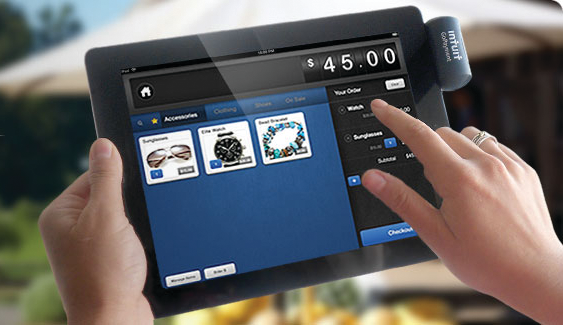Our society seems to be taking the “paperless” movement in all directions, including to our wallets. The mobile payment phenomenon is a part of this continuing shift, but one that has different pros and cons than traditional online payment or e-invoicing utilities.
Depends on the Business
Online banking is nothing new, of course. Technically, ATM machines are a form of remote banking that has been around for decades. But the era of the internet brought banking to our computers, and the mobile and smart phone age would quickly move many of those online banking functions to web-enabled devices, enabling the core of e-commerce.
Over the past four years, however, the attention has moved to retailers accepting credit and debit card payments using devices attached to their smart phones or tablets. With big small business technology companies like Intuit getting into the market with their GoPayment solution, and others like Square, PayAnywhere and others having a strong market share, the trend toward mobile payments has hit mass adapter status. But what are the real benefits, other than just being the next cool tech thing?
The last time we covered mobile payments was about two years ago, and while the market has grown, I still stand by my assessment that it can make the most sense for very small retailers or service providers. This is because they offer a low up-front cost way for these businesses to accept plastic, which has become a preferred payment method, especially for those under 40.
Best Fit
While TV commercials often also promote the use of mobile payments inside brick and mortar stores like florists or dine-in restaurants, I see the greatest benefit of mobile payments being for solo entrepreneurs, or those with a very small staff, whose service offering is mobile in nature. Think personal trainers, plumbers, delivery services, taxi services, lawn maintenance, and many other businesses that are inherently on-the-go.
For these types of businesses, it isn’t optional to carry around even a small, traditional point-of-sale system, and without the mobile device they might otherwise be left to taking credit card numbers over the phone, which is less reliable.
Low Cost
Since all the mobile payment systems require is a smartphone or tablet (usually iPhone, iPad, Android or BlackBerry device), which most Americans now seem to have, the only additional hardware necessary is the card reader itself which is usually free. The companies offering the services, including those mentioned above, make their revenue from a percentage of each transaction. This is usually 2-4 percent, sometimes with an additional small per-transaction fee (10-20 cents).
If selling a single cup of coffee, these fees are not so insignificant. For higher value transactions they might also be prohibitive. But for moderately-priced products and services, the fees can likely be incorporated into pricing.
Not a Good Fit
This is a column, and so this is my opinion, but I don’t see as much benefit for larger retailers or for those who have an invoicing model. The first category is almost always likely to see better cost-benefit from a true point-of-sale system, like those we review each year. For those that invoice, such as contracted professionals with recurring clients, online accounts receivables utilities like www.Bill.com can offer a streamlined management system that includes online payment capabilities.
Other types of businesses for which mobile payments might not be a fit are based on the nature of their transactions. High volume, low margin businesses could be more affected by the per transaction fees, as could those who have high dollar value per transaction. In other words, the 2-4 percent charge might be equal to the commission for a new furnace, and just wouldn’t be feasible for car dealerships or when a homeowner has a major remodel.
One other potential benefit, regardless of type of business: In the unlikely event of an electrical brownout or blackout, mobile cellular systems usually continue to work. This would allow mobile devices that are still charged to continue to accept payments, while most other systems would be down.
Note that on the following pricing chart, there is usually a higher transaction fee (up to 1% more) when manually entering a credit card instead of swiping it, and an additional transaction fee may apply.
Current Pricing for No-Contract Versions of Popular Mobile Payment Solutions
Intuit GoPayment (www.gopayment.com)
Swipe Fee: 2.75%
Transaction Fee: $0
Card Reader: Free
Minimums: NoneSquare (www.squareup.com)
Swipe Fee: 2.75%
Transaction Fee: $0
Card Reader: Free
Minimums: NonePayAnywhere (www.payanywhere.com)
Swipe Fee: 2.69%
Transaction Fee: $0
Card Reader: Free
Minimums: None
Other Systems
Businesses using Sage Software’s (na.sage.com/sage-payment-solutions) payment solutions can add a free mobile payment system for phones and tablets that has no additional processing fees over the cost of their payment solution.
PayPal (www.paypal.com) has recently added mobile payment acceptance to its business offerings, at a similar rate of 2.7% per transaction, along with check acceptance and email invoicing. Other complete details (such as keyed transaction rates) were not available. LevelUp (www.thelevelup.com) has a completely different approach, offering a 0% transaction fee, but using an ad campaign model that helps drive customers to the retailer, for a fee.
Google Wallet, which can store personal credit card and account information, is making its debut at retailers across the country, but is geared toward mobile customers, not mobile businesses. Most of the nation’s largest banks have also developed their own systems, but they have not yet attained a broad reach.
Thanks for reading CPA Practice Advisor!
Subscribe Already registered? Log In
Need more information? Read the FAQs
Tags: Small Business, Technology




